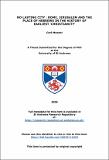Files in this item
No lasting city : Rome, Jerusalem and the place of Hebrews in the history of earliest 'Christianity'
Item metadata
| dc.contributor.advisor | Esler, Philip Francis | |
| dc.contributor.author | Mosser, Carl | |
| dc.coverage.spatial | vii, 381 leaves | en |
| dc.date.accessioned | 2017-06-19T12:49:06Z | |
| dc.date.available | 2017-06-19T12:49:06Z | |
| dc.date.issued | 2005 | |
| dc.identifier | uk.bl.ethos.664301 | |
| dc.identifier.uri | https://hdl.handle.net/10023/11022 | |
| dc.description.abstract | The contemporary study of Hebrews is bedeviled by anachronistic assumptions that distort its interpretation. As a result, Hebrews holds a paradoxical position in contemporary New Testament scholarship. After two centuries of critical study little progress has been made on core introductory issues related to this epistle. Consequently, many scholars are hesitant to utilize it significantly for investigation into the origin and early development of Christianity. In contrast, Hebrews specialists generally agree that Hebrews is a sermon that was sent to a group of Christians in Rome. Some scholars even utilize it as a primary datum in the investigation of Roman Christianity. This thesis consists of a ground-clearing exercise and prolegomena for reexamining the place of Hebrews in early Christian history. It begins by arguing that Hebrews should not be read as a document of early Christianity, a religion separate from Judaism, but as a document of Second Temple Judaism. It then assesses the arguments for locating the recipients in Rome. When the evidence is subjected to critical scrutiny we find that it precludes an Italian location. Likewise, the arguments against locating the readers in Palestine fail and the evidence actually points in that direction. Finally, the idea that Hebrews is a sermon is disproved and new insight is gained into the situation that the epistle addresses. Significantly, we find that the reference to a "word of exhortation" in 13:22 refers to an oracle received by the readers which they were hesitant to obey. The positive argument contends that Hebrews was sent to Jerusalem. New exegetical insight into Rahab's commendation (11:31) gives strong support to this contention. Additional support comes from the Temple Scroll, 4QMMT and other Jewish texts which help prove that camp in 13:13-14 is a legal term of art that refers to Jerusalem. These texts also help us see that the "strange teachings" in 13:9 refer to halakhic innovations related to sacrifice. The readers reside in Jerusalem and are urged to leave the city before it is destroyed. | en_US |
| dc.language.iso | en | en_US |
| dc.publisher | University of St Andrews | |
| dc.subject.lcc | BS2775.52M7 | |
| dc.subject.lcsh | Bible. Hebrews--Criticism, interpretation, etc | en |
| dc.title | No lasting city : Rome, Jerusalem and the place of Hebrews in the history of earliest 'Christianity' | en_US |
| dc.type | Thesis | en_US |
| dc.type.qualificationlevel | Doctoral | en_US |
| dc.type.qualificationname | PhD Doctor of Philosophy | en_US |
| dc.publisher.institution | The University of St Andrews | en_US |
This item appears in the following Collection(s)
Items in the St Andrews Research Repository are protected by copyright, with all rights reserved, unless otherwise indicated.

